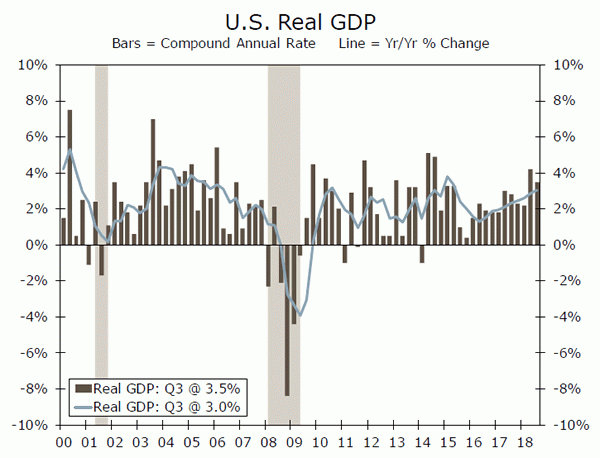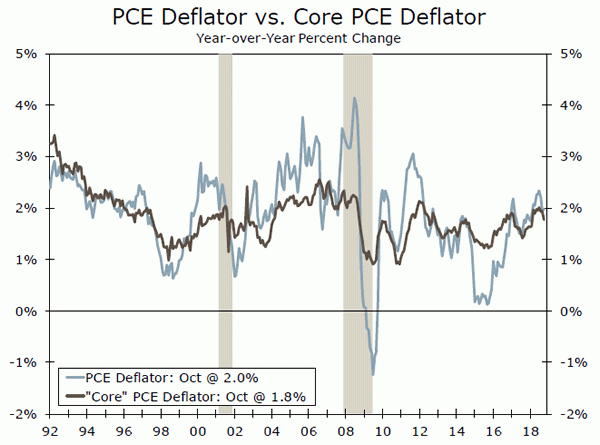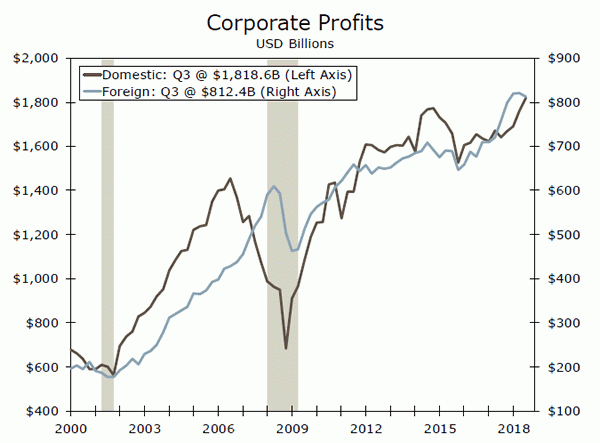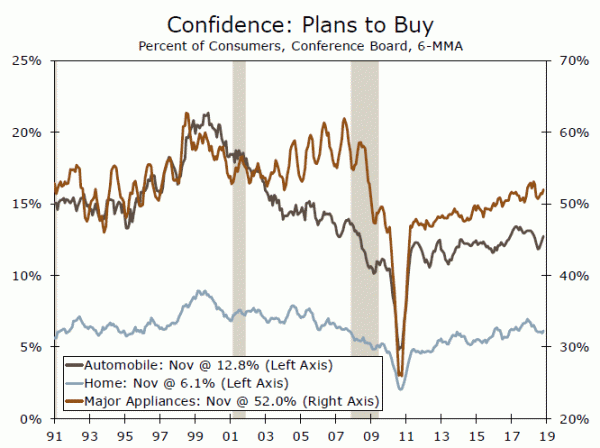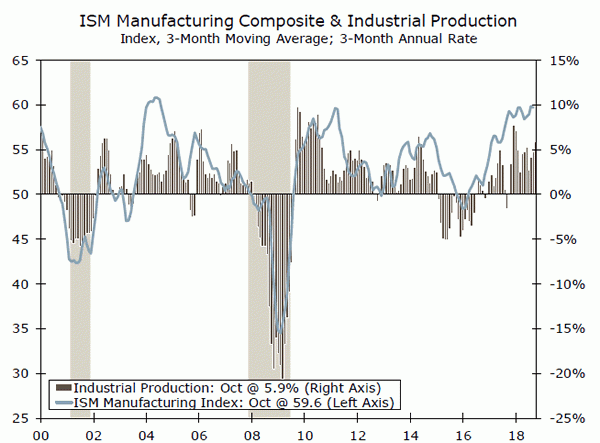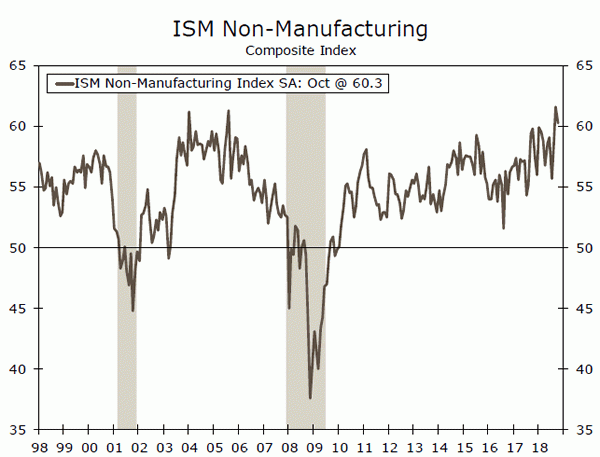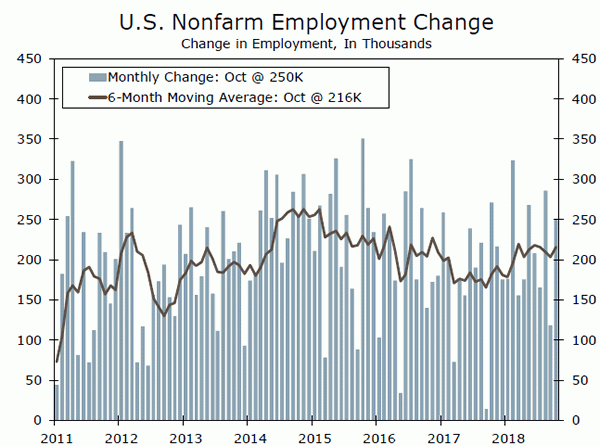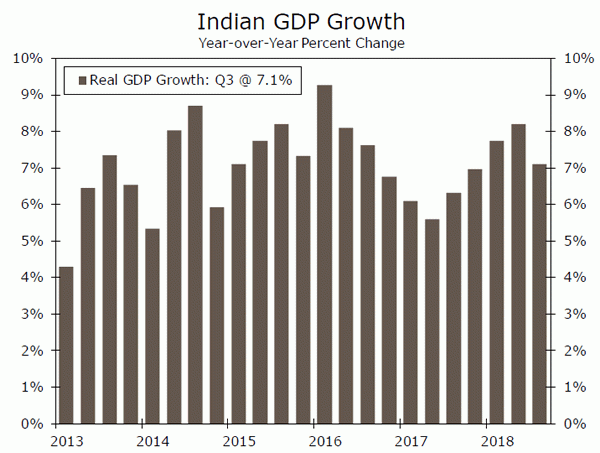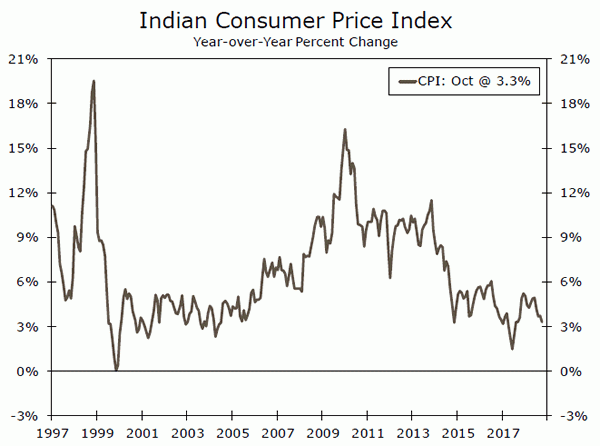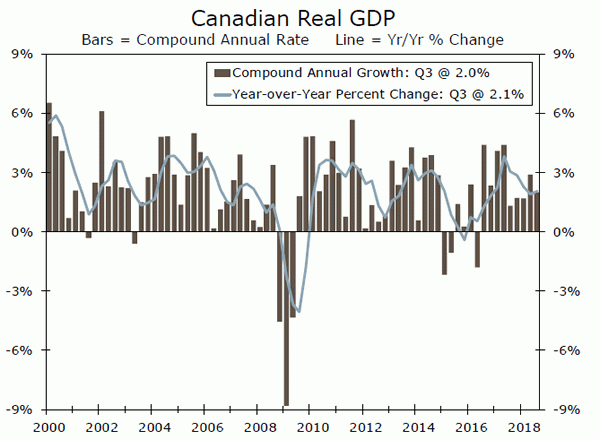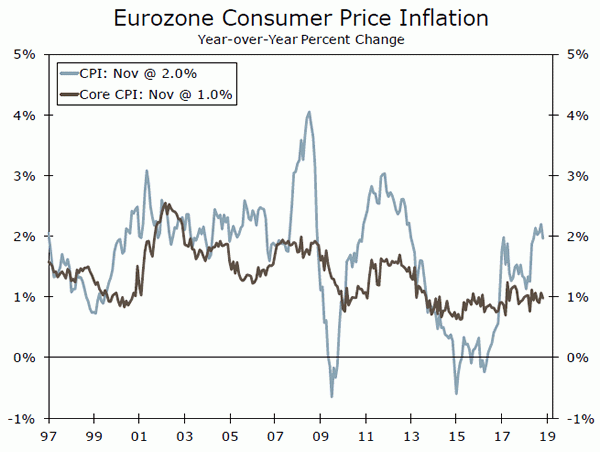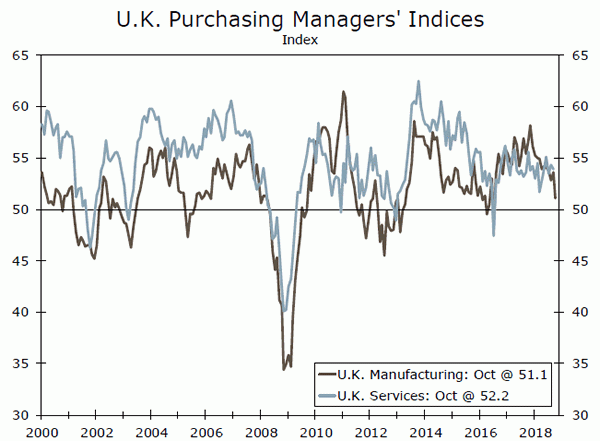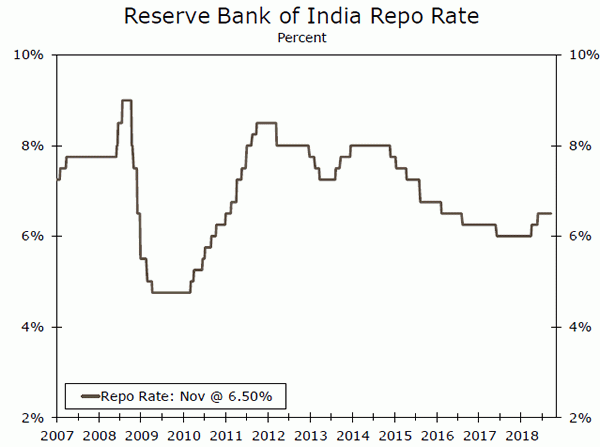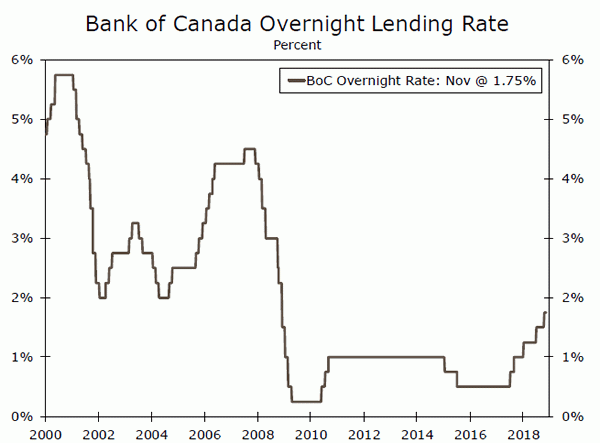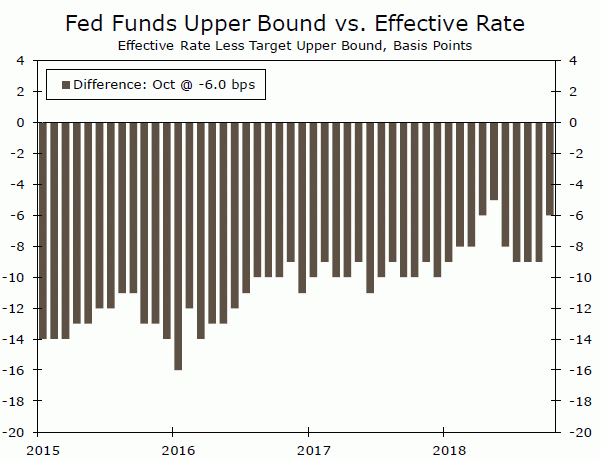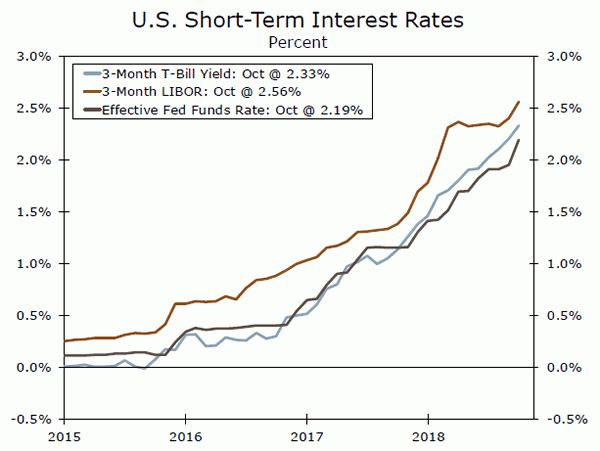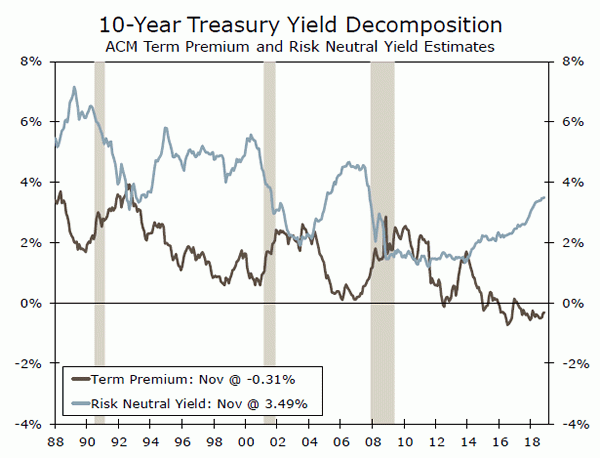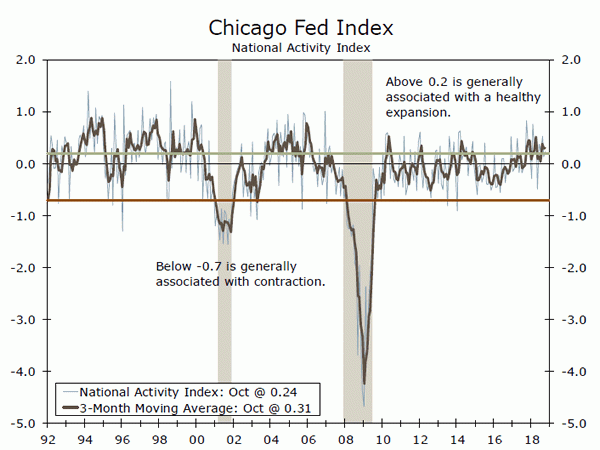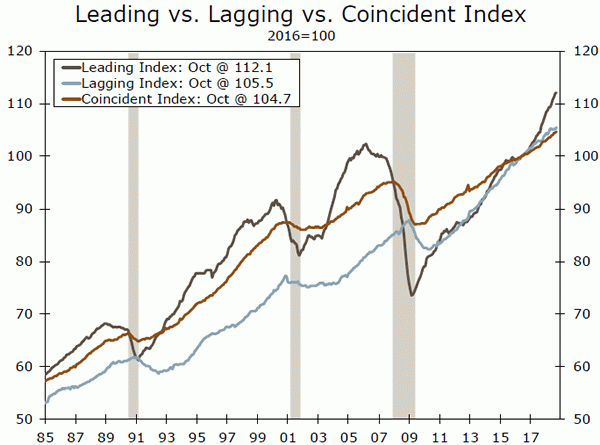U.S. Review
“There is a great deal to like about this outlook”
- A speech by Federal Reserve Chairman Jerome Powell this week introduced some uncertainty into analysts’ estimates of just how many rate hikes could be left in the current expansion. But, with the PCE deflator unchanged at 2.0% in October, the Fed looks set to raise rates again at its December meeting.
- Economic data out the gate this week point to a positive outlook. The second estimate of Q3 GDP kept growth at an annualized rate of 3.5%, underpinning strong growth in corporate profits. Fresh consumer confidence and personal income data point to strong consumer spending to end the year.
“There is a great deal to like about this outlook”
Federal Reserve Chairman Jerome Powell addressed the Economic Club of New York this week. While the main topic of discussion was financial stability, financial markets and analysts alike found particular interest in Powell’s comment regarding the neutral rate: “Interest rates are still low by historical standards, and they remain just below the broad range of estimates of the level that would be neutral for the economy.” This language introduced some uncertainty into analysts’ estimates of just how many rate hikes could be left in the current expansion.
While the probability of a December rate hike has come down recently, it remains quite elevated at 78.6%. Similarly, the PCE deflator remained unchanged at 2.0% in October, giving the Fed cover to raise rates at its December meeting. We still look for the Fed to raise rates four more times in this cycle–at its upcoming December meeting and three more times next year. Powell’s broader comments about the economic outlook leaned slightly upbeat. He said, “There is a great deal to like about this outlook,” and the economic data out the gate this week would agree.
The second estimate of Q3 GDP left headline growth unrevised at an annualized pace of 3.5%. Personal consumption was revised lower, but declines here were balanced by modest upward revisions to investment spending. The volatile trade environment also caused a larger than initially reported build in inventories, although this was offset by a greater drag from net exports.
Solid GDP growth underpinned strength in Q3 corporate profits, with before tax profits rising 10.3% on a year-ago basis, which is the fastest pace since 2012. But, while domestic profits continue to exhibit the strength of the U.S. economy, slow global growth and recent dollar strength caused foreign profits to slip $7.7B in Q3.
Consumers remained confident in November. After reaching an 18-year high in October, consumer confidence fell this month, but remained at a still elevated reading of 135.7. The three-month average remained at a cycle high, and suggests current optimism will sustain strong consumer spending to end the year. Consumers’ expectations regarding rate-sensitive purchases (autos, homes & major appliances) six-months ahead have remained elevated– suggesting little evidence of higher rates weighing on consumers. But, as we expect the Fed to continue to raise rates into next year, increased borrowing costs may begin to weigh on purchases.
While confidence suggests strong spending to end the year, the October personal income and spending data also affirm our forecast for consumer spending to grow nearly 3.0% in Q4. Personal income shot up 0.5% in October, with every category of income improving over the month. Personal spending rose a strong 0.6%, but the prior month’s increase was revised slightly lower. The gradual normalization of monetary policy through rate hikes has been a headwind to the housing market and raised some concern about the sustainability of consumer outlays on durable goods. Just as we didn’t see consumers shy away from such purchases in November’s confidence figures, there was little evidence of it in October’s durables spending, which rose 0.4%.
U.S. Outlook
ISM Manufacturing • Monday
The ISM manufacturing index has been flying high this year, although the series fell more than two points in October. The headline ISM still looks strong against “hard” data on production and new orders. Therefore, we don’t expect much of a rebound for November and anticipate the index to be remain near its current level. Respondents indicate ongoing challenges related to trade, input costs and labor availability. The dollar’s strength and slowdown in global trade are also beginning to weigh on export orders.
A steeper decline than what we forecast may weigh on markets, but would be unlikely to stop the FOMC hiking in December given that the ISM has looked somewhat out of line with other manufacturing data recently. An upside surprise, on the other hand, would signal the factory sector is weathering a tougher trade environment and increase the likelihood of further tightening in early 2019.
Previous: 57.7 Wells Fargo: 57.8 Consensus: 57.6
ISM Non-Manufacturing • Wednesday
Economic activity outside the factory sector has been on a tear according to the ISM non-manufacturing sector. The index eased a touch in October from a 21-year high the previous month, but at 60.3 remains near the highest levels of the past two decades.
We expect the non-manufacturing index to ease a bit more in November, as the mining sector has come under pressure and construction and real estate have faced headwinds from higher interest rates. Nevertheless, the index should remain at a level consistent with solid growth across the broad economy. Another lofty reading would point to GDP growth holding up well in the fourth quarter and ease concerns that the trade environment is hitting the domestic-facing service sector. A significantly weakerthan- expected print, however, would signal the economy is beginning to slow from the break-neck pace of the past two quarters.
Previous: 60.3 Wells Fargo: 59.1 Consensus: 59.1
Employment • Friday
Employment growth has remained robust this year, with employers adding an average of 212,000 jobs per month year to date. After rising 250K in October, we expect hiring to have slowed in November as jobless claims have ticked up. Unemployment is expected to stay at 3.7%. Wages should rise 0.3%, supported by a tight labor market generally and Amazon increasing its minimum wage specifically.
It is worth a reminder that one month of data does not make a trend, and that is particularly true when it comes to the jumpy and heavily revised payroll numbers. That makes it unlikely in our view that even a large downside miss would lead the Fed to hold off on a rate hike in December. If, however, the next couple of months’ jobs numbers show the trend in hiring is slowing, that could put the FOMC on a more gradual upward path in 2019. An upside surprise to payrolls or wages in November would point to the FOMC being likely to raise rates more than markets currently have priced in for 2019.
Previous: 250,000 Wells Fargo: 215,000 Consensus: 200,000
Global Review
Several GDP Releases Point to Mixed Q3 Growth
- India’s economy moderated in Q3, with real GDP growth slowing more than expected to 7.1% year over year. Inflation has also pulled back in recent months, likely supporting only a gradual pace of rate hikes on the part of the central bank.
- Q3 real GDP growth in Canada also slowed from its Q2 pace, however the recent trade deal has removed much of the uncertainty surrounding its economy in recent months, and we still look for the central bank to raise rates three times in 2019.
- In Europe, both Switzerland and Sweden’s economies unexpectedly contracted in Q3, while Eurozone inflation data confirm that price pressures are still only slowly rising.
Several GDP Releases Point to Mixed Q3 Growth
Amid several GDP releases this week, the Indian economy grew 7.1% year-over-year in Q3, a larger-than-expected slowdown from the standout 8.2% gain in Q2 (see chart on first page). Although GDP growth decelerated in Q3, India still has one of the most rapidly expanding economies in the developing world of late. However, price pressures have eased in recent months (top chart), and are likely a roadblock to a more rapid pace of rate hikes on the part of the central bank, along with more moderate growth.
While we still look for sustained expansion in India going forward, continued trade tensions weighing on China, its top trading partner, could eventually affect growth prospects in India as well. U.S.-China trade policy remained in focus this week ahead of a highly anticipated meeting between U.S. President Trump and Chinese President Xi this weekend as part of the G-20 Summit. With previously imposed tariffs on China set to increase to 25% from 10% in January and an additional $267 billion in tariffs threatened, market participants will be closely watching the outcome of the meeting and its implications for trade policy.
Continuing the theme of national accounts data released this week, real GDP in Canada slowed to a 2.0% annualized rate in Q3, (middle chart). However, as we have previously written, the trade deal reached last month with the U.S. and Mexico removes much of the uncertainty surrounding the Canadian economy in earlier months and should support growth in investment spending and exports. But these changes will likely take time, as business fixed investment contracted at a 6.5% annualized pace in Q3 after only a tepid 0.3% gain in Q2, while exports only rose 0.9%. Although these sectors look to be a near-term drag on growth, the overall economy is still expanding at a moderate pace, and along with a solid labor market and inflation that is largely anchored, we look for the BoC to hike rates three times in 2019.
Turning to Europe, real GDP in Sweden and Switzerland unexpectedly contracted 0.2% (not annualized) in both countries. In Sweden, it looks as if some of the weakness was due to temporary factors such as new emission tests that weighed on auto sales, a phenomenon that also affected Germany’s Q3 output. In Switzerland, however, international trade slowed sharply, and the broader contraction is telling of the slower pace of growth occurring across much of Europe.
So what does slower growth in the Eurozone mean for the European Central Bank (ECB)? The ECB has previously stated that it intends to wrap up its asset purchase program by the end of this year, but keep interest rates unchanged “at least through the summer of 2019.” However, these plans rely on its medium-term inflation and growth outlook coming into focus. Preliminary inflation data for November released today show that underlying price pressures are still only slowly rising. Growth in the core index dipped slightly to 1.0% year-over-year, while the headline index also moderated (bottom chart). While we still look for inflation to pick up as GDP growth should also recover, these two indicators will likely need to show sustained upward momentum before the ECB moves to raise rates.
Global Outlook
U.K. Manufacturing PMI • Monday
The U.K. manufacturing PMI dropped sharply in October, falling 2.5 points to 51.1 and continuing its downward trend. The hard data largely confirm the sentiment data; industrial production growth has been flat over the past two months, while investment spending again declined in Q3, contracting 1.2% on a sequential basis. Ongoing Brexit concerns look to be largely to blame for the slowing trend in the manufacturing sector, as businesses postpone investment decisions until further clarity is reached on the outcome of negotiations. While an initial deal was reached with the European Union earlier this month, several U.K. ministers resigned in the wake of the agreement, leading market participants to question the feasibility of the U.K. parliament signing off on the deal before the March 2019 deadline. While our base case is still for an orderly outcome to be reached before the deadline, uncertainty will likely continue to weigh on U.K. growth prospects in the meantime.
Previous: 51.1 Consensus: 51.7
Reserve Bank of India • Wednesday
The Reserve Bank of India (RBI) has only slowly begun to tighten monetary policy, remaining on hold at its October meeting after raising rates 50 bps earlier this year. At the same time, economic growth slowed in Q3, with real GDP rising 7.1% year over year, lower than the 8.2% gain in Q2 that was the fastest rate since early 2016.
Price pressures have also receded in recent months. Consumer price inflation recently dipped below the 4% upper bound of the RBI’s target range, and registered a slower 3.3% year-over-year increase in October. The recent slide in global oil prices could also restrain price appreciation in coming months, and likely gives mixed signals to the central bank in terms of the appropriate path of monetary tightening. Given the recent moderation in economic growth along with an already cautious central bank, most market participants look for the RBI to remain on hold next week and continue to only gradually raise rates in coming quarters.
Previous: 6.50% (Repo Rate) Consensus: 6.50% (Repo Rate)
Bank of Canada Decision • Wednesday
Rounding out a week of central bank decisions, we look for the Bank of Canada (BoC) to remain on hold next week after raising rates 25 bps at its October meeting. Although we look for rates to remain unchanged at its upcoming meeting, we also look for the BoC to continue to tighten policy roughly in line with the Federal Reserve’s rate hike trajectory.
The Canadian economy appears to be performing solidly at present, and we learned this week that real GDP rose at a 2.0% annualized rate in Q3, albeit slower than the standout 2.9% pace registered in Q2. At the same time, the labor market remains tight, with the unemployment rate remaining below 6% in October and updated data for November are also due next week. Although the recent dip in global oil prices could weigh on Canada’s large energy sector going forward, the economy is still growing above potential, and we look for the BoC to raise rates three times in 2019.
Previous: 1.75% Wells Fargo: 1.75% Consensus: 1.75%
Point of View
Interest Rate Watch
Getting Technical
When the Federal Open Market Committee (FOMC) makes its policy decisions, it sets a target range of 25bps in which the effective fed funds rate is permitted to float. The effective fed funds rate has recently drifted toward the upper bound of the target range, repeating a phenomenon that occurred earlier this year and eventually led to a “technical adjustment” in the way the Fed operationally influences short-term interest rates (top chart). This adjustment entailed increasing the interest on excess reserves (IOER) rate by a bit less than the target range for the fed funds rate is increased.
Minutes from the FOMC’s November meeting released yesterday showed that the committee is again contemplating another technical tweak due to a similar issue. For most market participants, this would mean nothing more than an effective fed funds rate that, for now, is pushed back closer to the middle of the Fed’s target range. As seen in the middle chart, the current monetary policy system has been generally quite successful at pulling up short-term interest rates in the economy across a range of different financial instruments.
However, with two technical tweaks possible in the span of six months, the stars appear to be aligning for a broader and deeper look at the Fed’s monetary policy tools and outlook. The minutes revealed that the Federal Reserve may be thinking along similar lines and is starting to undertake a broader rethink of its long-run monetary policy framework. This could entail ending balance sheet normalization earlier than policymakers had earlier anticipated, and could even go as far as eventually adopting a new policy rate.
Our baseline scenario remains that the Fed will end its balance sheet unwind by late 2019/early 2020. With the balance sheet still being fairly large at that point, this would mean some additional and permanent suppression of long-term interest rates relative to the pre-crisis era, all else equal (bottom chart).
For more on this topic, see our recent special report “Getting Technical: Managing the Fed Funds Rate” available on our website and upon request.
Credit Market Insights
Staying Stable
Shocks to the economy are inherently hard to predict, but what about gradually forming imbalances? Cognizant of the role that excesses played in the last crisis, the Federal Reserve this week released its inaugural Financial Stability Report, with the goal of assessing the resilience of the U.S. financial system. Were any shocks to occur, how well could the financial system weather the storm, and are any sectors particularly vulnerable?
The Fed notes, as have we, that household borrowing has grown roughly in line with the overall economy, and is largely concentrated among low risk households. Banks are well capitalized and hold more liquid assets compared to a decade ago. The report suggests some caution, however, regarding business debt and asset valuations. Corporate debt is at record levels and increasingly in the form of high yield bonds and leveraged loans. Lowered credit standards and historically low spreads suggest high levels of risk taking. Additionally, commercial real estate (CRE) prices have outpaced rents and have raised fears of a bubble.
We have likewise identified corporate debt and CRE as potential imbalances forming in the economy. However, in our view neither is overly concerning at present. We do not see CRE or excessive corporate leverage as a near-term catalyst for the next downturn, but we are certainly monitoring them as attention rightfully focuses on potential vulnerabilities in the economy.
Topic of the Week
What the Cycle Indicators Are Telling Us
With the current expansion just seven months shy of the longest on record, the top question we get is: “When will the next recession start?” The quick answer is probably not too soon. The longer answer will be addressed with the publication of our annual outlook and conference call next week.
A common follow-up to the recession question is: “what one or two indicators should I follow to track where we are in the cycle?” One possible solution for that is to look at the business cycle indicators. The Chicago Fed publishes its National Activity Index monthly. It is essentially a weighted average of 85 indicators. Like a well-diversified investment portfolio, this approach smooths some of the volatility and helps provide a bird’s eye view of where we are in the cycle. A number greater than zero implies the economy is growing faster than its long term average and a negative print signals below trend growth. Below -0.7 implies outright contraction.
The October number this week came in at 0.24, a number that is generally associated with a healthy expansion, even though it has come off the boil over the past six months or so.
Conference Board Measures
If you are more interested in honing in on peaks and troughs in the business cycle, the Conference Board maintains three separate composite indexes. These too, are designed to smooth some of the volatility of individual measures, but as the names imply, each offers a different sort of economic signal: where we have been, where we are now and where we are headed.
All three of these indicator cocktails are feeling some cheer as they move steadily higher, though here too, the pace of ascent has slowed. Look at the bottom chart and you’ll note that in this cycle for the first time in at least the past 30 years, the lagging index is higher than the coincident measure. When the lagging-to-coincident measure goes lower (or negative as it is now) that can be a warning sign. By any reckoning, it is getting late in the cycle.




